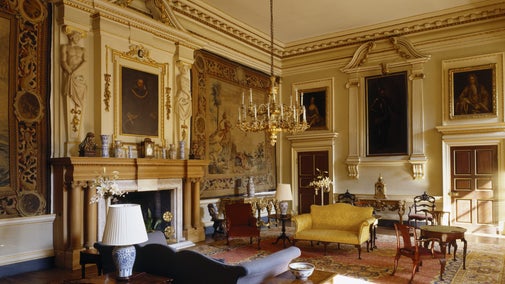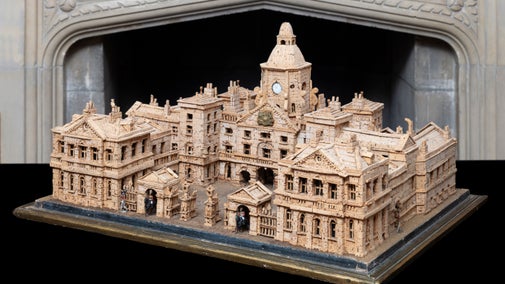29 March 2023
Preparing for transport
The tapestry will be removed from the wall in the Stag parlour under supervision of the Textile Conservation team. It will be rolled and prepared for transport.

This 17th century tapestry will be restored to its full glory with thanks to the National Trust remedial conservation fund. This tapestry is part of a larger series, three of which are displayed at Lyme; together they tell the story of Prince Cadmus, the founder of the city of Thebes.
"Cadmus Sent in Search of Europa" is a 17th century tapestry which will be restored to its full glory with thanks to the National Trust remedial conservation fund. This tapestry is part of a larger series, three of which are displayed at Lyme; together they tell the story of Prince Cadmus, the founder of the city of Thebes. The works will take 3 years and 1500 hours to complete and cost around £150,000.
This series of tapestries were produced by Michiel Wauters in Antwerp in the late 17th century. We don't know when they were acquired and brought to Lyme or by whom.
The main type of damage tapestries such as this suffer are from broken threads caused from contunual use, insect damage and damp. Gravity acts on the weakest parts of the structure, gradually causing decay over time.

Tapestries in the halls of manor houses were displays of wealth and provided insulation and decoration. Biblical and mythological stories were common themes. These tapestries tell the mythological story of Cadmus, the founder of the city of Thebes. This Greek myth was popularised by the Roman poet Ovid in "The Metamorphoses," a series of mythico-historical stories from the creation of the world to the deification of Julius Caesar.
29 March 2023
The tapestry will be removed from the wall in the Stag parlour under supervision of the Textile Conservation team. It will be rolled and prepared for transport.

Everyone needs nature, now more than ever. Donate today and you could help people and nature to thrive at the places we care for.

Inspiring, leading and resourcing the UK’s heritage to create positive and lasting change for people and communities, now and in the future.
Inside the house you can discover unusual objects and strange secrets from six centuries of family history at Lyme in Cheshire.

Discover more about our work at the Textile Conservation Studio in Norfolk, the National Trust’s only specialist in-house textile conservation facility.

See the breadth of our collection of works of art, furniture and more: we care for around a million objects at over 200 historic places, there’s a surprise discovery around every corner.

The art and heritage collections we care for rival the world’s greatest museums. Learn more about the collection of paintings, decorative art, costume, books, household and other objects at historic places.
